Life with the Lenovo Yoga 2 Pro
by Brett Howse on July 30, 2014 2:00 PM EST- Posted in
- Notebooks
- Lenovo
- Windows 8.1
- Yoga
Wi-Fi Performance
Most Ultrabooks are at the point where they are too thin to even include a standard Ethernet port, and the Yoga 2 Pro is no exception. As a consumer device, this is generally not an issue as most laptops are used over Wi-Fi anyway, so a high quality wireless card is important. Unfortunately the Intel Wireless-N 7260 (an M.2 card which integrates Bluetooth 4.0) has some major features missing for a $1099 laptop. The lack of 802.11ac support might be forgivable, since 802.11ac is fairly new, but the fact that this card has only 2x2 TX/RX stream support at 2.4GHz can be a deal breaker for many people. It’s somewhat sad that in 2014, a premium device can be sold without 5GHz Wi-Fi.
I understand there are margins to maintain, but for a device that lives entirely on Wi-Fi, a small amount spent here would help a lot. On Amazon.com, the price difference between the Intel Wireless-N 7260 ($10) and the Dual-Band Intel Wireless-N 7260, which supports 5GHz, is $10, and moving up to the AC version is only another $10. It would be unlikely Lenovo is paying that much per card. On a $1000 laptop, this isn't acceptable Wi-Fi.
Let’s take a look at the Wi-Fi performance:
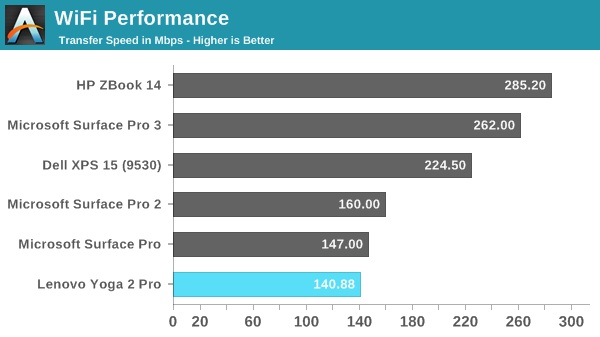
When running these performance tests, I could not get the device to connect at anything higher than 144 Mbps, even on a router with just this device connected. Troubleshooting that led me to a newer driver version for the Intel wireless card (dated June 2014) and once installed I was immediately able to connect at the maximum of 300 Mbps. Keep in mind however that interference on 2.4GHz is pretty high for most areas, so this is very much a best-case scenario.
Even with a 300Mbps connection, maximum transfer speed was not great with the Yoga 2 Pro only achieving 141 Mbps. This is a real disappointment on a device with a price tag of around the thousand dollar mark. A 5GHz connection should be the minimum acceptable level here.
While doing research on the wireless card choice, I found several people who recently purchased a Yoga 2 Pro which they claim comes with the Intel Wireless AC 7260 card which would improve this result quite a bit. I've reached out to Lenovo to verify this information and will post an update if they confirm it.
Tablet Performance
Due to the dual nature of the Yoga 2 Pro, we can also compare it to other two-in-one devices and tablet performance. Being an i5-4200U, it should easily outperform Bay Trail equipped two-in-one devices and be more in line with the Surface Pro offerings. Compared to ARM based tablets, it will be significantly faster.
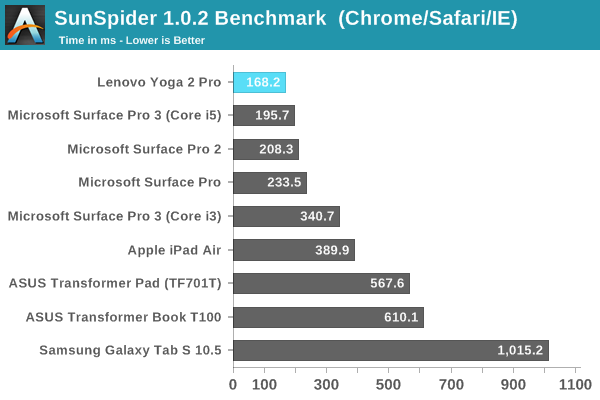
Sunspider is a light workload that tests single-threaded performance. The Core i5 in the Yoga 2 Pro comes out on top.
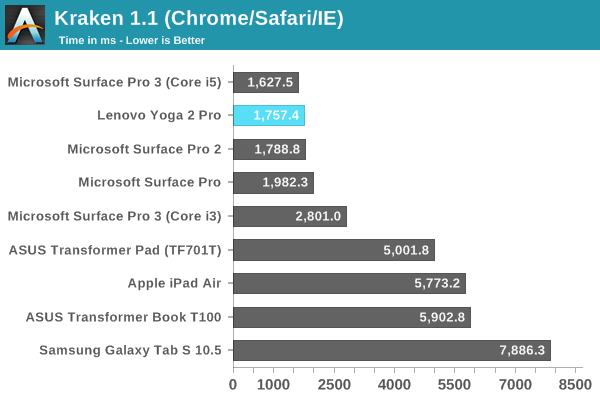
Kraken is similar to Sunspider, with the Core series pulling an even greater advantage over Bay Trail and ARM based tablets.
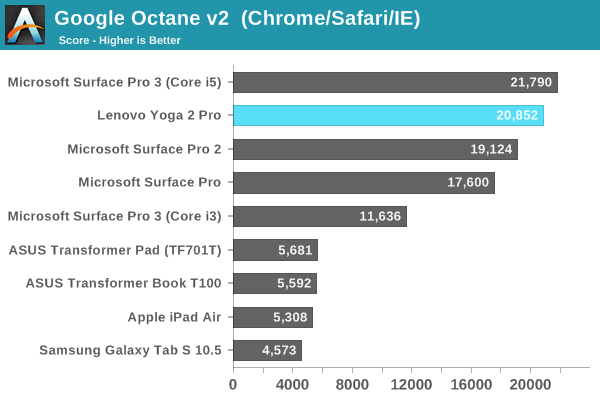
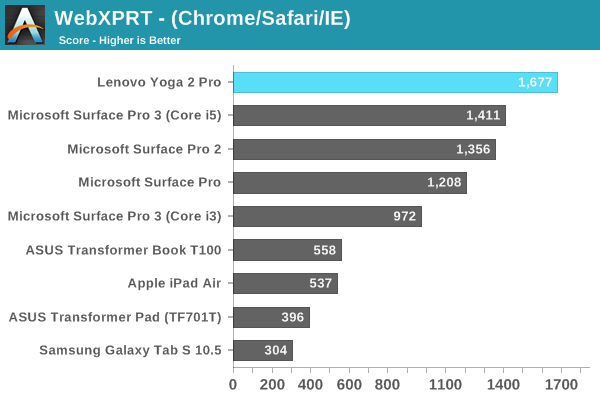
The more complex the javascript load gets, the further the Core series pull away from everything else. The Core i5 pulls a pretty substantial lead over the i3-4020Y of the Surface Pro 3 due to the lack of Turbo Boost on the i3 model, even though the base clock speeds are similar.
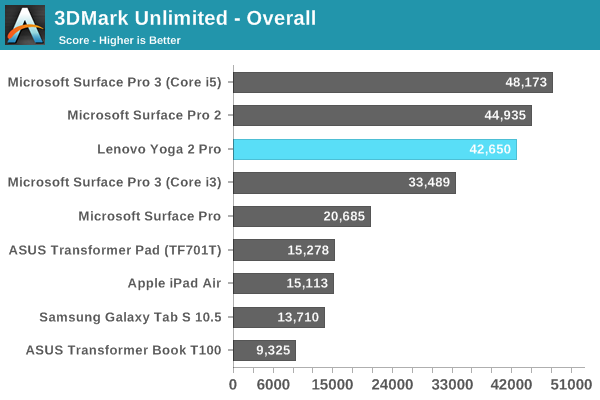
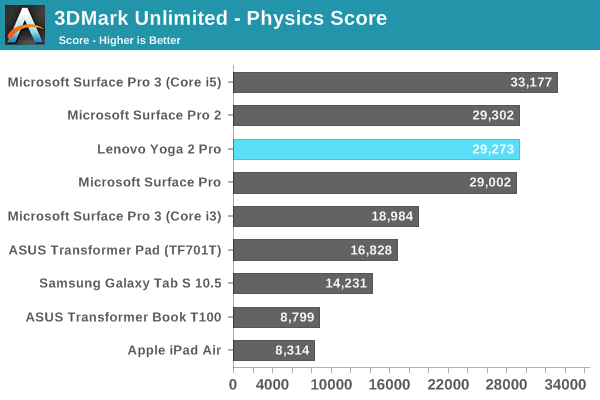
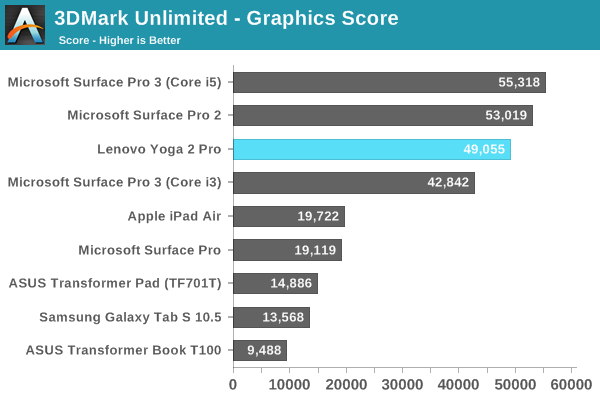
Graphics performance, while not spectacular as a laptop, is very good compared to tablet form factor devices.
As an outright tablet, the Yoga 2 Pro is plenty fast, but being based on a laptop it isn’t designed to imitate a pure tablet experience. For instance, it does not feature support for Connected Standby, so the standard sleep mode for this is to use S3 sleep instead, so wake from sleep can take several seconds.
These comparisons to tablets show that the Core series has a substantial performance lead over the competition, however it has to be noted that the ARM and Bay Trail competitors are in a completely different power envelope. These benchmarks show why you may want to use a device like the Yoga 2 Pro with touch. The performance is still quite a leap from the true tablet devices out there, making tasks like web browsing a better experience.










103 Comments
View All Comments
bullzz - Wednesday, July 30, 2014 - link
"advertised clock speed of 1.6 GHz with all four cores at 100% usage"isnt this a dual core CPU
JarredWalton - Wednesday, July 30, 2014 - link
There are two virtual cores as well, so this was tested with a 4-threaded load.mapesdhs - Wednesday, July 30, 2014 - link
Even so, it's not correct to refer to four cores, that could easily confuse people.Personally I don't know how Intel gets away with using the i7 label for these
CPUs when they're all just dual core.
Ian.
TiGr1982 - Wednesday, July 30, 2014 - link
1. Then one should refer to four threads (as Intel names it itself officially).2. Well.. AFAIU, "i7" is just a brand, meaning "the top notch among its device class", happens to have HT, and in general has nothing to do with the particular number of physical cores:
1) i7 has 2 cores in ULV class
BUT
2) i7 has 4 cores in medium/big laptop class
3) i7 has 4 cores in mainstream desktop class
BUT
4) i7 has 6 (soon to be 8) cores in extreme desktop class
So "i7" is just a brand, supposed to make the customer think "Wow, this thing is gonna be fast".
As Semiaccurate founder calls it "iSomethingmeaningless" from the point of purely tech specs per se.
Brett Howse - Wednesday, July 30, 2014 - link
Thanks for the comment you are of course correct, it's 2 physical cores and 4 threads. Looks like Jarred already edited that sorry for the confusion.Dug - Thursday, July 31, 2014 - link
Same with i5. My desktop i5 is quad core, but my laptop is dual core.TiGr1982 - Friday, August 1, 2014 - link
Indeed; only i3 is more or less consistent (2 cores, 4 threads, no Turbo).Besides, Pentium and Celeron (based on big cores) are also consistent (when one does take into account Atoms rebranded as Celeron and Pentium).
TiGr1982 - Friday, August 1, 2014 - link
I meant, "when one does NOT take into account Atoms rebranded as Celeron and Pentium".Alexey291 - Saturday, August 2, 2014 - link
Essentially Intel CPU branding is a sordid mess - after all is said and done :)wetwareinterface - Sunday, August 3, 2014 - link
actually the pentium branding is anything but consistent right now.there are pentium cpus out right now that are based on 3rd generation dual core i3's with half the cache
dual core low voltage i3 half cache and 1-200 Mhz lower clocks than u series i3
and dual core 4th generation cores with no quick sync and hd 4000
and quad core 4th gen with quick sync enabled and hd 4000